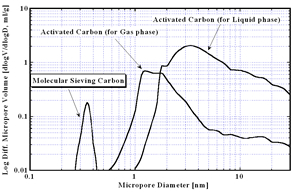

| 進口代理產品 | |
| 美國UOP | |
| 德國BF碳分子篩 | |
| 韓國Cosmo | |
| 日本武田JKC | |
| 法國Bostik | |
| 法國CECA | |
| 土耳其NEDEX |
日本武田
Activated Carbon Contributes to Ecology.
Activated carbon, as material to improve deteriorated living condition from industrialization and urbanization and to ensure well-being, is utilized in a wide variety of fields. As a familiar application, you can find it in cigarette filters and water purifier. Industrial field includes food and drug manufacturing, chemical industry and others; on a global level, water quality improvement and prevention of air pollution are notable examples. The demand of activated carbon is ever growing as our lifestyle has recently become affluent and convenient.
Over 70 years since 1936, when we imported the production technology from Germany, Japan EnviroChemicals has rolled out numerous activated carbons, under the brand name of SHIRASAGI, gaining trust and acclaim for technological excellence, quality and performance.
MOLSIEVON for gas separation and high-purity nitrogen separation and concentration from air, is high performance carbon, the superbness of our technology, with the largest annual production capacity in the world. Granulated SHIRASAGI-G series has through the ages been used for deodorizing purposes. The latest product called Granulated SHIRASAGI-GM2x is designed to remove malodorous substances at a time with a single layer. We have a wide assortment of products with distinctive features such as SHIRASAGI DO series for dioxin containing exhaust gas treatment and Spherical SHIRASAGI DX7-3 for effluent treatment.
In addition to sophisticated adsorption technology to unfailingly separate target trace components, our strength is technical service to select the most appropriate carbon and determine the necessary amount in consideration of operating life, adsorption scale, target substance to be removed, and facility condition. We strive to offer extremely precise service taking full advantage of accumulated technical knowhow from untiring research and development and of a wealth of customer supports.
We practice procurement of raw material all the way to release of finished product to ensure stable production and supply. We provide for escalating raw material shortage by means of availing ourselves of our overseas production base, investigating unexplored sources in an Asian bloc, and forming an alliance with other suppliers. We achieve unimpeded supply of products through securing broad-based sales channels.
We will proactively work on a recycle system to regenerate used carbon for the purpose of nourishing a safer, cleaner environment while continuing unflinching innovation.
Molecular Sieving Carbon (MSC) or Carbon Molecular Sieves (CMS)
Molecular Sieving Carbon (MSC) or Carbon Molecular Sieves (CMS) is generally defined as a carbonaceous adsorbent with uniform supermicro pores of smaller than 10 angstrom in pore diameter.
We, Japan EnviroChemicals, Ltd., are a world’s largest manufacturer of Molecular Sieving Carbon in the world. Molecular Sieving Carbon products manufactured by Japan EnviroChemicals, Ltd. are well known as the brand name of “SHIRASAGI MSC.” The production capacity of our Molecular Sieving Carbon is 1,500MT per year.
Our former parent company, TAKEDA put into the world's first commercial production of Molecular Sieving Carbon of 5A in 1969. Since we took over TAKEDA’s technologies, we have been improving the pore size adjustment technique.
Characteristic of Molecular Sieving Carbon (MSC) or Carbon Molecular Sieves (CMS)
As shown in figure 1, the activated carbon generally used for gas and liquid adsorption has well developed micro and transitional pores of 10 to 500 angstrom in pore diameter. On the other hand, Molecular Sieving Carbon has only uniform supermicro pores of smaller than 10 angstrom in pore diameter.
Application of Molecular Sieving Carbon (MSC) or Carbon Molecular Sieves (CMS)
Molecular Sieving Carbon is widely used for gas separation. One of the most typical applications is nitrogen PSA (Pressure Swing Adsorption). Nitrogen PSA is classified into the PSA system using velocity separation, which makes use of the difference of adsorption velocity between nitrogen and oxygen. The performance of PSA is largely affected by the property of Molecular Sieving Carbon. It is because the difference of molecular sizes is very small between oxygen compound (0.28nm×0.40nm) and nitrogen compound (0.30nm×0.41nm). The effective difference for the velocity separation can be obtained only when you use Molecular Sieving Carbon which uniform supermicro pores are highly controlled in figure 1. The best Molecular Sieving Carbon is precisely controlled so as to have slightly larger pores than nitrogen compound. This well control results in that the nitrogen compound is harder to adsorb and the oxygen compound is easier to adsorb. Japan EnviroChemicals, Ltd. has high-end technologies and know-how regarding pore controls.
Standard Grades of our Molecular Sieving Carbon (MSC) or Carbon Molecular Sieve (CMS)
SHIRASAGI 3K-172 SHIRASAGI 3R-172 Pellet diameter
1.8mmφ 1.8mmφ Particle size(%)
2.800-1.180mm
99.0% min.2.360-1.000mm
99.0% min.Half cycle time(sec)
60 60 Recovery(%)
37.0 min. 40.5 min. Productivity(Nm3/hr.ton)
180 - 200 205 - 220
隱私權聲明•法律條款•版權所有:嘉烈達集團(喜田屋貿易公司)@2007




